wheel torque Ram 5500 Chassis Cab 2012 Diesel Supplement
[x] Cancel search | Manufacturer: RAM, Model Year: 2012, Model line: 5500 Chassis Cab, Model: Ram 5500 Chassis Cab 2012Pages: 173, PDF Size: 1.29 MB
Page 18 of 173
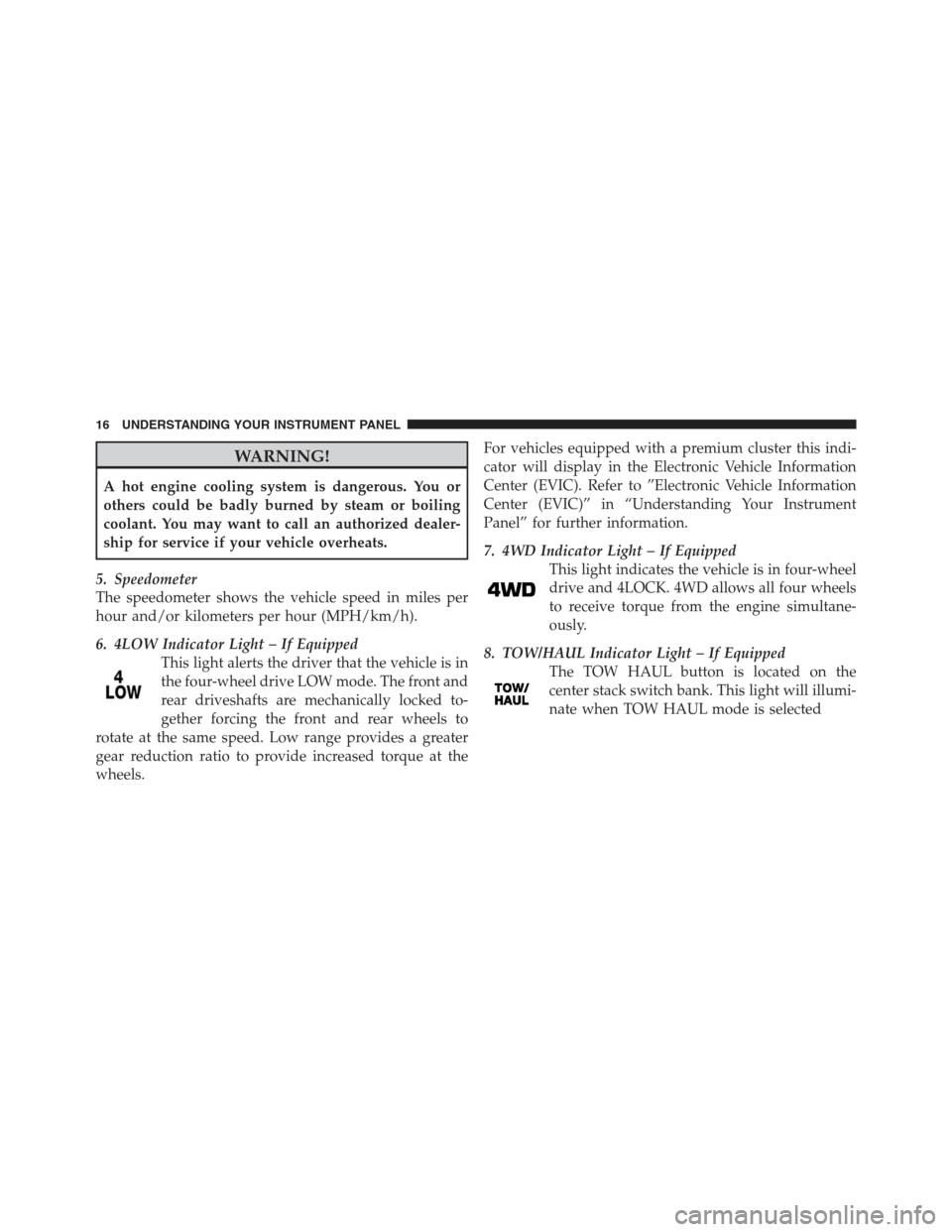
WARNING!
A hot engine cooling system is dangerous. You or
others could be badly burned by steam or boiling
coolant. You may want to call an authorized dealer-
ship for service if your vehicle overheats.
5. Speedometer
The speedometer shows the vehicle speed in miles per
hour and/or kilometers per hour (MPH/km/h).
6. 4LOW Indicator Light – If Equipped This light alerts the driver that the vehicle is in
the four-wheel drive LOW mode. The front and
rear driveshafts are mechanically locked to-
gether forcing the front and rear wheels to
rotate at the same speed. Low range provides a greater
gear reduction ratio to provide increased torque at the
wheels. For vehicles equipped with a premium cluster this indi-
cator will display in the Electronic Vehicle Information
Center (EVIC). Refer to ”Electronic Vehicle Information
Center (EVIC)” in “Understanding Your Instrument
Panel” for further information.
7. 4WD Indicator Light – If Equipped
This light indicates the vehicle is in four-wheel
drive and 4LOCK. 4WD allows all four wheels
to receive torque from the engine simultane-
ously.
8. TOW/HAUL Indicator Light – If Equipped The TOW HAUL button is located on the
center stack switch bank. This light will illumi-
nate when TOW HAUL mode is selected
16 UNDERSTANDING YOUR INSTRUMENT PANEL
Page 53 of 173
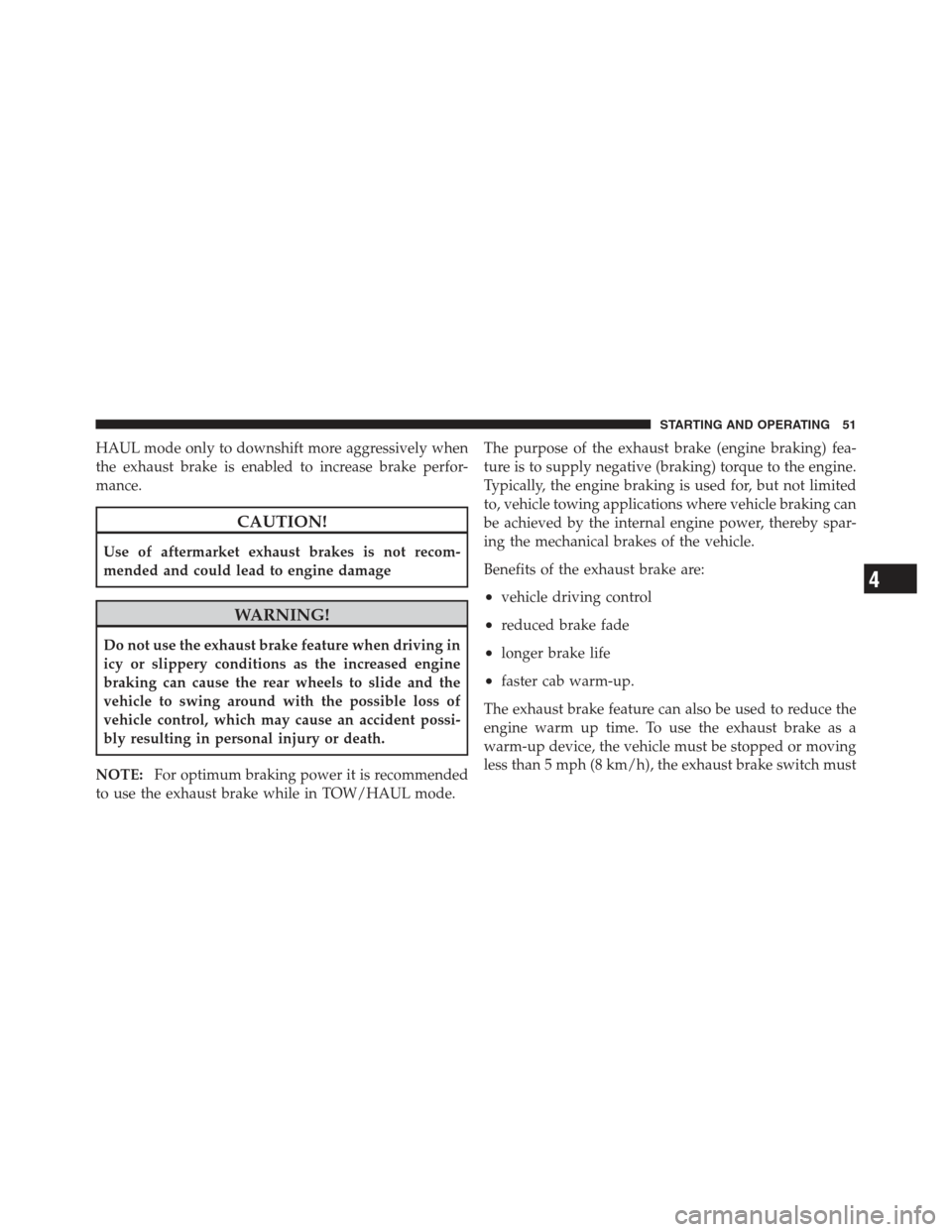
HAUL mode only to downshift more aggressively when
the exhaust brake is enabled to increase brake perfor-
mance.
CAUTION!
Use of aftermarket exhaust brakes is not recom-
mended and could lead to engine damage
WARNING!
Do not use the exhaust brake feature when driving in
icy or slippery conditions as the increased engine
braking can cause the rear wheels to slide and the
vehicle to swing around with the possible loss of
vehicle control, which may cause an accident possi-
bly resulting in personal injury or death.
NOTE: For optimum braking power it is recommended
to use the exhaust brake while in TOW/HAUL mode. The purpose of the exhaust brake (engine braking) fea-
ture is to supply negative (braking) torque to the engine.
Typically, the engine braking is used for, but not limited
to, vehicle towing applications where vehicle braking can
be achieved by the internal engine power, thereby spar-
ing the mechanical brakes of the vehicle.
Benefits of the exhaust brake are:
•vehicle driving control
•reduced brake fade
•longer brake life
•faster cab warm-up.
The exhaust brake feature can also be used to reduce the
engine warm up time. To use the exhaust brake as a
warm-up device, the vehicle must be stopped or moving
less than 5 mph (8 km/h), the exhaust brake switch must
4
STARTING AND OPERATING 51
Page 65 of 173
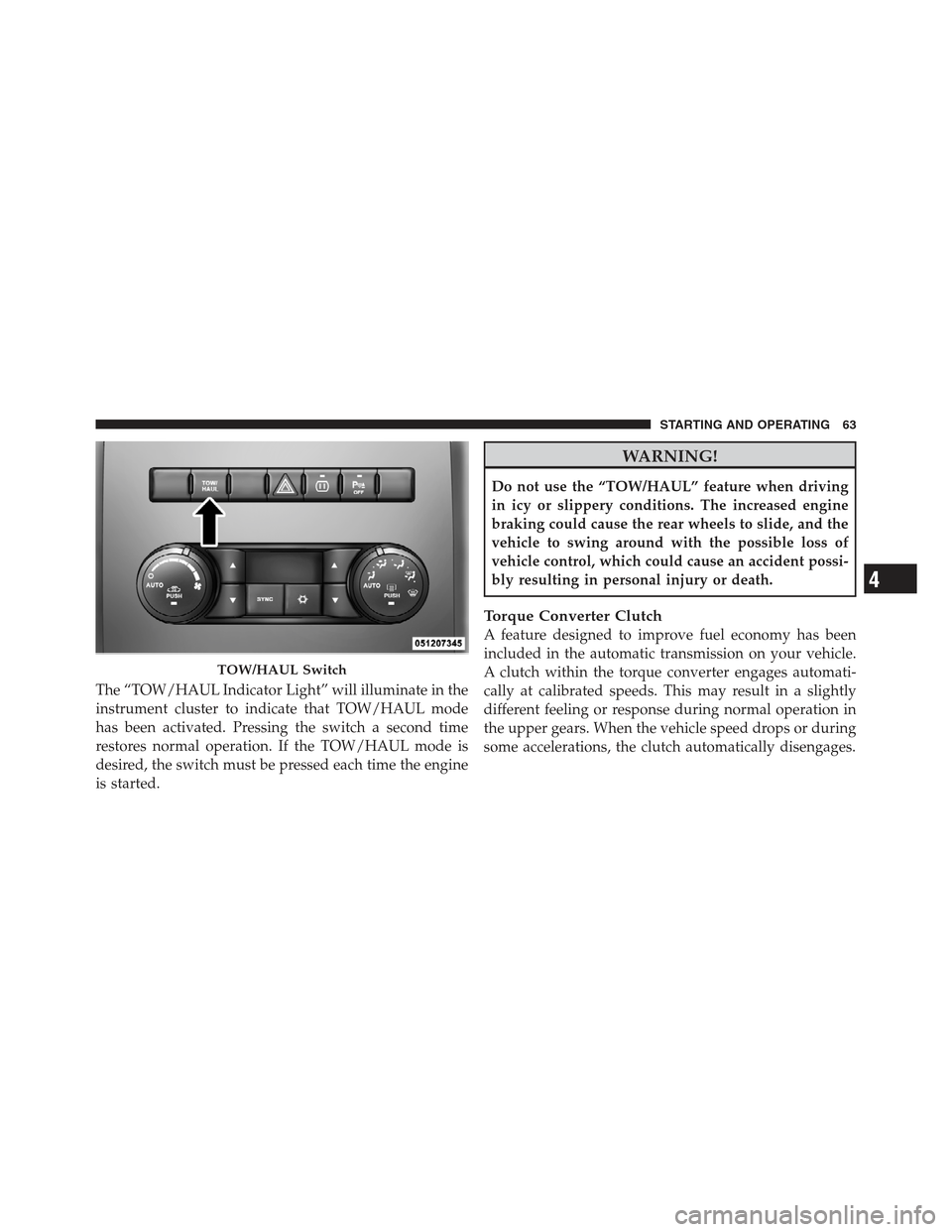
The “TOW/HAUL Indicator Light” will illuminate in the
instrument cluster to indicate that TOW/HAUL mode
has been activated. Pressing the switch a second time
restores normal operation. If the TOW/HAUL mode is
desired, the switch must be pressed each time the engine
is started.
WARNING!
Do not use the “TOW/HAUL” feature when driving
in icy or slippery conditions. The increased engine
braking could cause the rear wheels to slide, and the
vehicle to swing around with the possible loss of
vehicle control, which could cause an accident possi-
bly resulting in personal injury or death.
Torque Converter Clutch
A feature designed to improve fuel economy has been
included in the automatic transmission on your vehicle.
A clutch within the torque converter engages automati-
cally at calibrated speeds. This may result in a slightly
different feeling or response during normal operation in
the upper gears. When the vehicle speed drops or during
some accelerations, the clutch automatically disengages.
TOW/HAUL Switch
4
STARTING AND OPERATING 63
Page 76 of 173
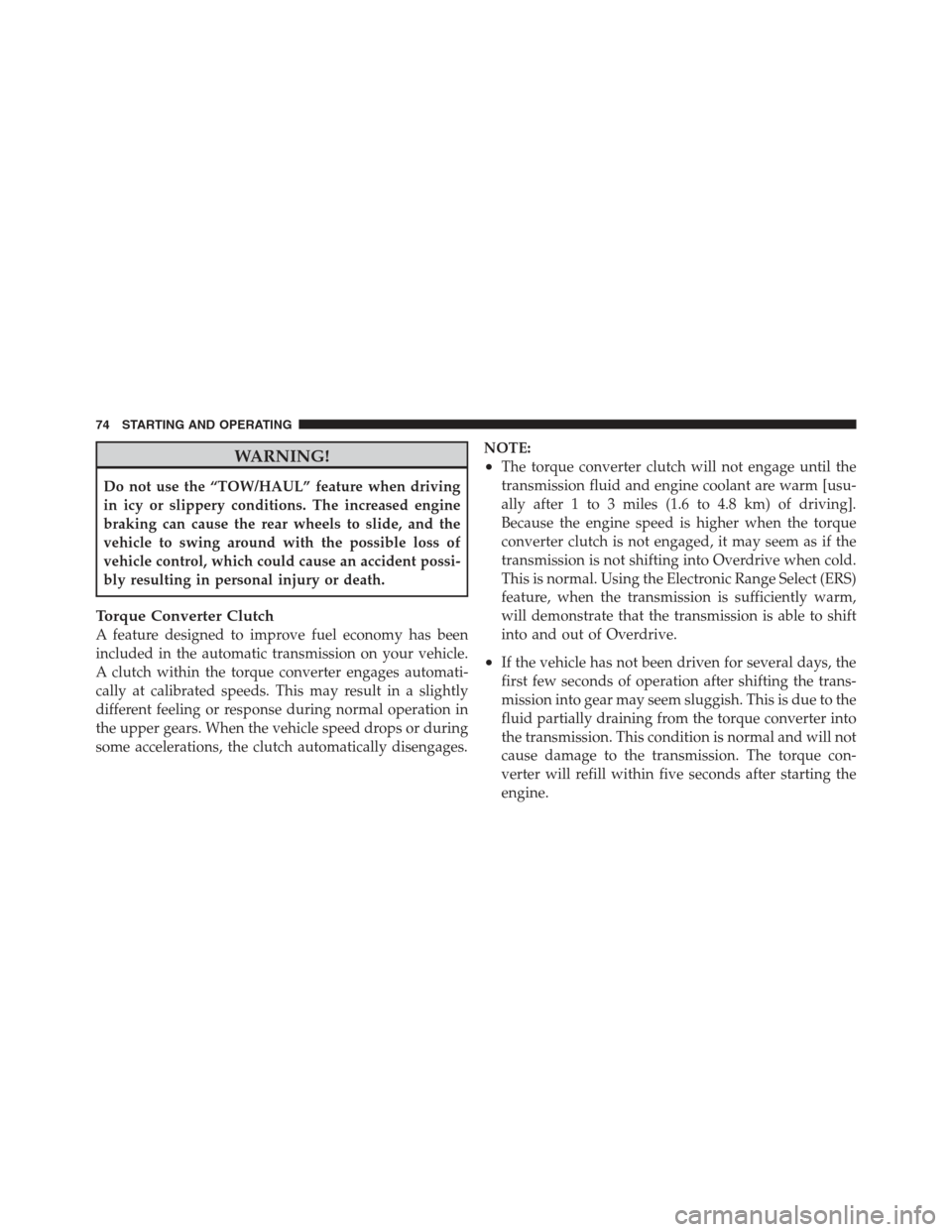
WARNING!
Do not use the “TOW/HAUL” feature when driving
in icy or slippery conditions. The increased engine
braking can cause the rear wheels to slide, and the
vehicle to swing around with the possible loss of
vehicle control, which could cause an accident possi-
bly resulting in personal injury or death.
Torque Converter Clutch
A feature designed to improve fuel economy has been
included in the automatic transmission on your vehicle.
A clutch within the torque converter engages automati-
cally at calibrated speeds. This may result in a slightly
different feeling or response during normal operation in
the upper gears. When the vehicle speed drops or during
some accelerations, the clutch automatically disengages.NOTE:
•The torque converter clutch will not engage until the
transmission fluid and engine coolant are warm [usu-
ally after 1 to 3 miles (1.6 to 4.8 km) of driving].
Because the engine speed is higher when the torque
converter clutch is not engaged, it may seem as if the
transmission is not shifting into Overdrive when cold.
This is normal. Using the Electronic Range Select (ERS)
feature, when the transmission is sufficiently warm,
will demonstrate that the transmission is able to shift
into and out of Overdrive.
•If the vehicle has not been driven for several days, the
first few seconds of operation after shifting the trans-
mission into gear may seem sluggish. This is due to the
fluid partially draining from the torque converter into
the transmission. This condition is normal and will not
cause damage to the transmission. The torque con-
verter will refill within five seconds after starting the
engine.
74 STARTING AND OPERATING
Page 171 of 173
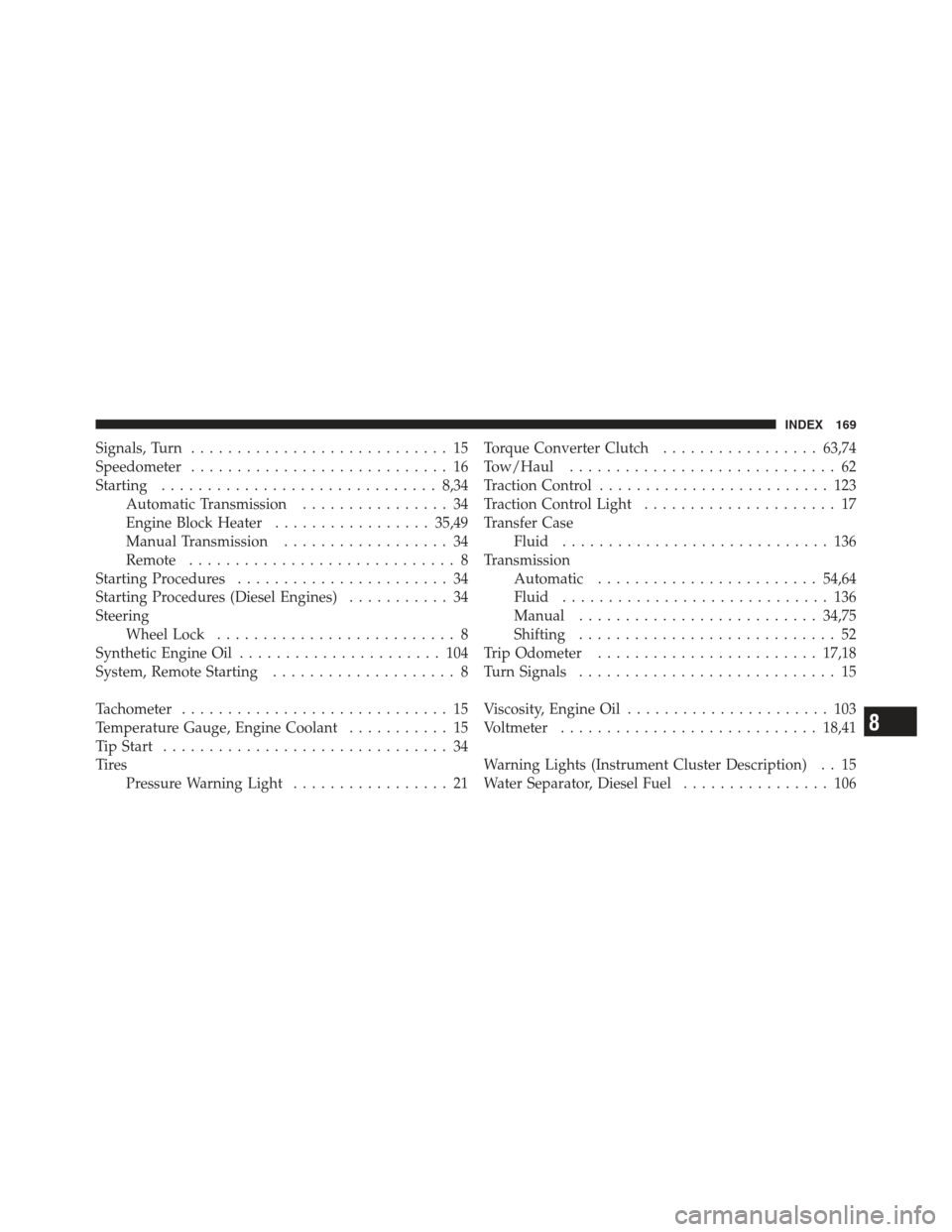
Signals, Turn............................ 15
Speedometer ............................ 16
Starting .............................. 8,34
Automatic Transmission ................ 34
Engine Block Heater ................. 35,49
Manual Transmission .................. 34
Remote ............................. 8
Starting Procedures ....................... 34
Starting Procedures (Diesel Engines) ........... 34
Steering Wheel Lock .......................... 8
Synthetic Engine Oil ...................... 104
System, Remote Starting .................... 8
Tachometer ............................. 15
Temperature Gauge, Engine Coolant ........... 15
Tip Start ............................... 34
Ti re s Pressure Warning Light ................. 21 Torque Converter Clutch
.................63,74
Tow/Haul ............................. 62
Traction Control ......................... 123
Traction Control Light ..................... 17
Transfer Case Fluid ............................. 136
Transmission Automatic ........................ 54,64
Fluid ............................. 136
Manual .......................... 34,75
Shifting ............................ 52
Trip Odometer ........................ 17,18
Turn Signals ............................ 15
Viscosity, Engine Oil ...................... 103
Voltmeter ............................ 18,41
Warning Lights (Instrument Cluster Description) . . 15
Water Separator, Diesel Fuel ................ 106
8
INDEX 169